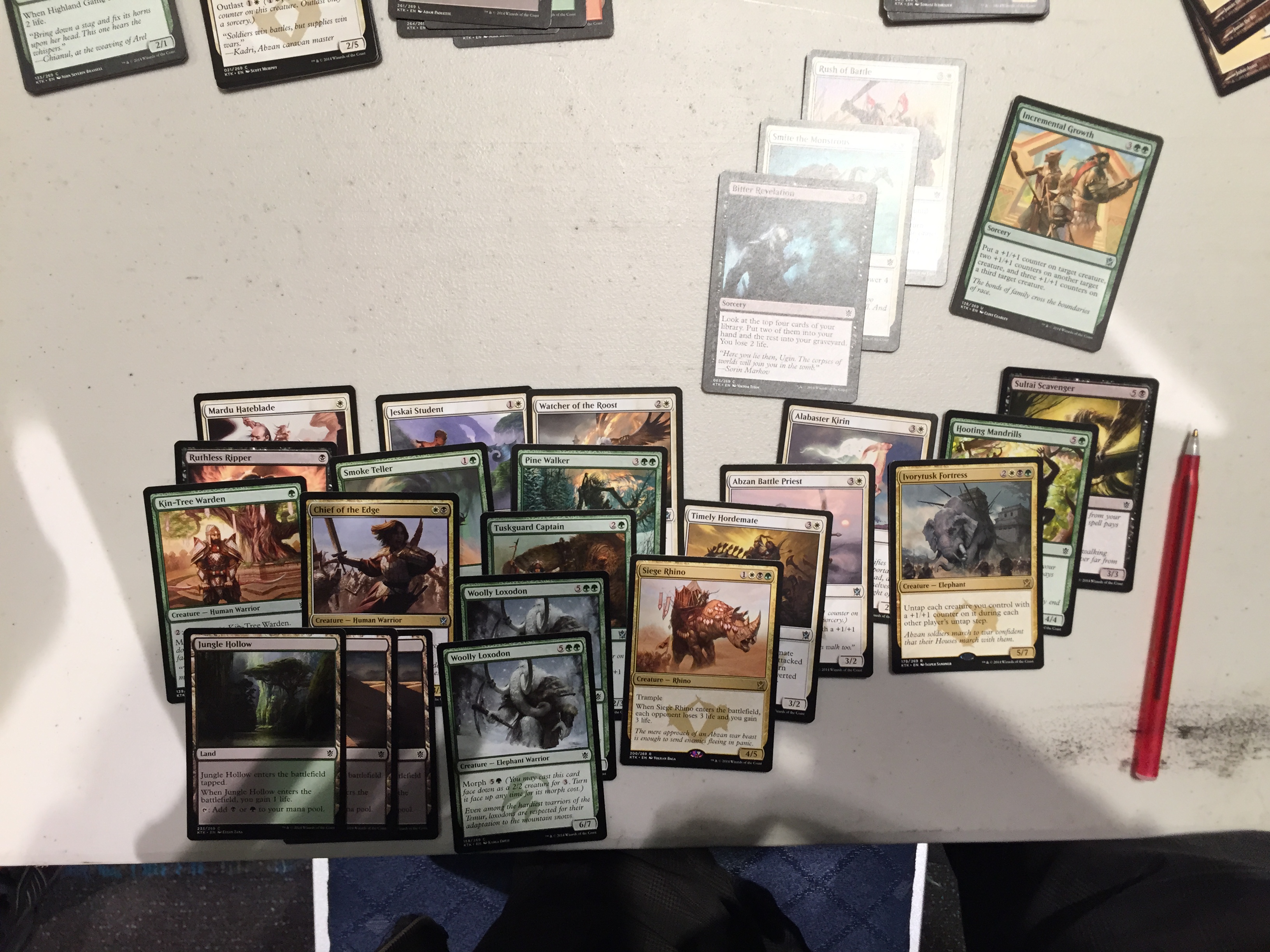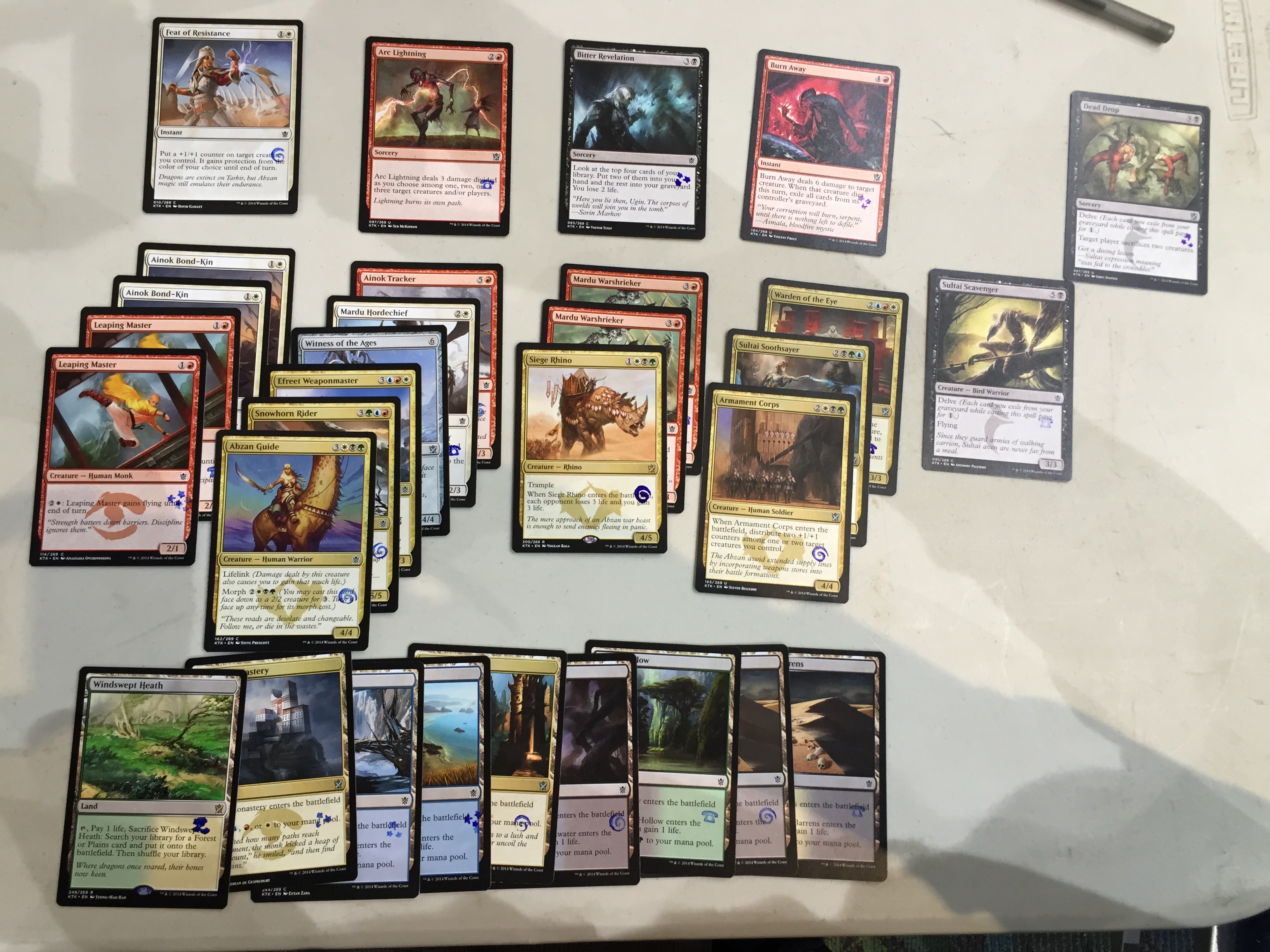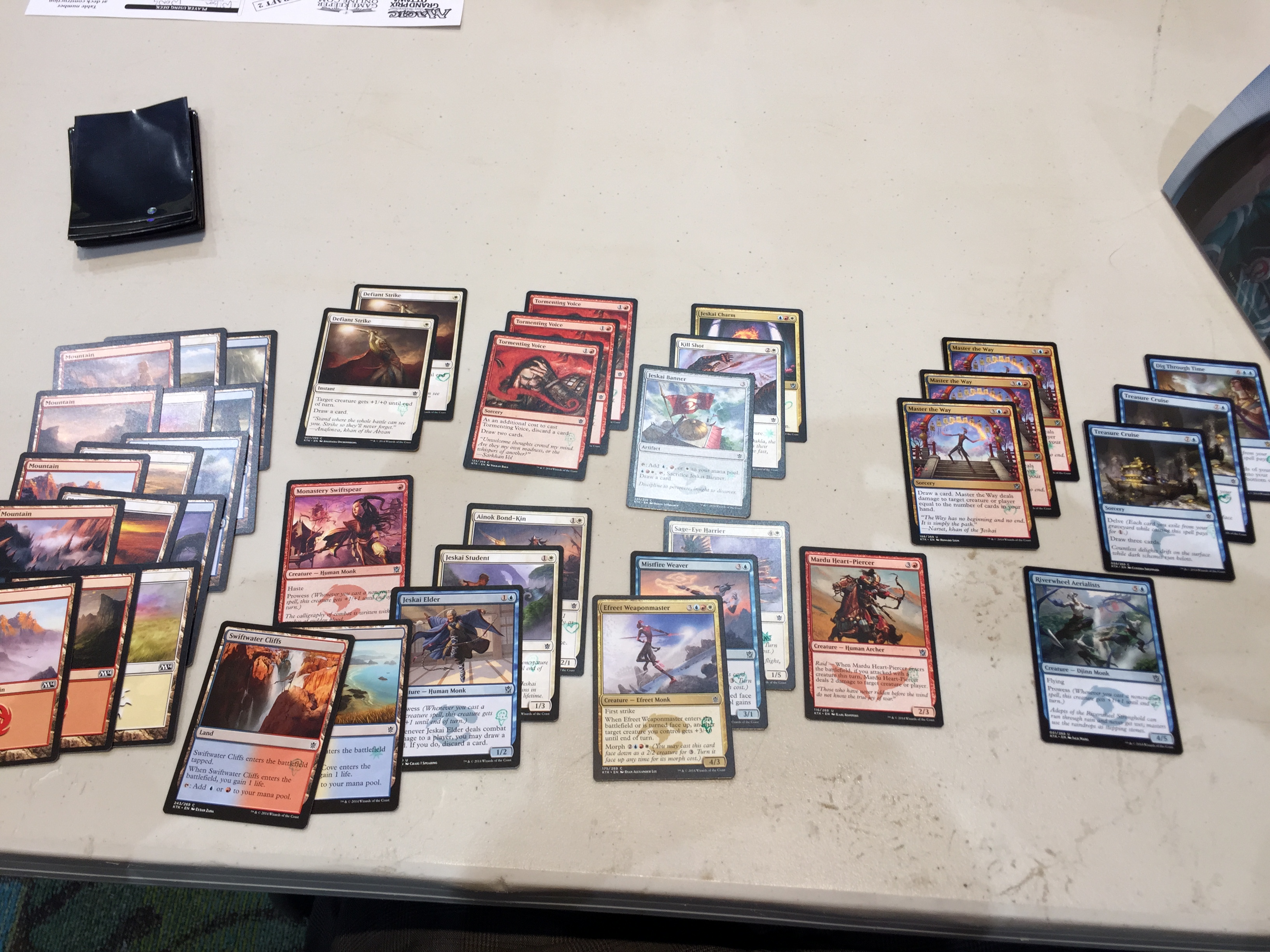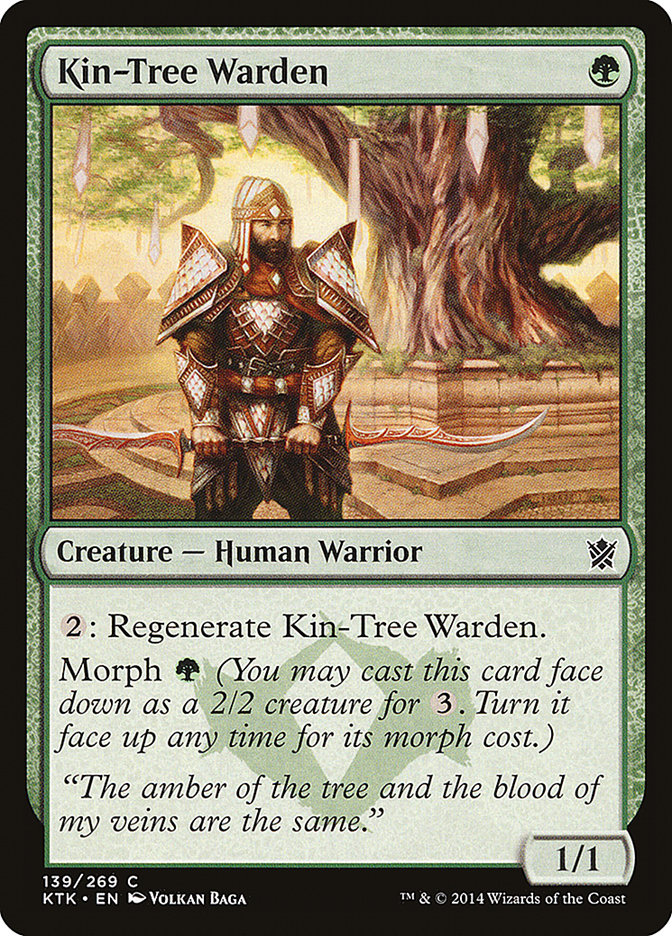Just before leaving for Grand Prix Ottawa, I really regretted my decision to go to the tournament. I liked the format and I thought I’d have a good time,
but I’m not working with any other competitors to prepare for the World Championship, and taking a weekend away from testing was suddenly starting to look
like a pretty bad idea. Beyond that, the fact that I was really in crunch time on preparing for Standard and Modern meant that I couldn’t justify doing
anything to prepare for Grand Prix Ottawa, so it would be my first individual Sealed tournament with six KTK packs.
Building for my Sealed was reasonably straightforward. I didn’t really have an incentives or enablers to play red. I had some sweet Jeskai cards, but no
nonbasic lands in any of those color combinations, so I just couldn’t use them. I could play Abzan to use my Siege Rhino and Ivorytusk Fortress, I could
play blue to play Dig Through Time and Pearl Lake Ancient, or I could try to play all of it.
The mana for playing all of it was really bad, and the fact that my pool had absolutely no cheap removal would really punish me if I went that way. My
Abzan deck’s only removal spell was Smite the Monstrous. My U/G deck had Force Away, two Disdainful Strokes, Cancel, Blinding Spray, and Set Adrift. This
means I wasn’t great at interacting with my opponent with either deck unless Disdainful Stroke was good. I decided my best plan would be to play the more
aggressive Abzan deck and try to ignore my opponent’s cards and end the game as quickly as possible. If my opponent had Duneblast, End Hostilities, Dead
Drop, or other really powerful expensive spells, I’d side into the deck that could counter them and win lategame with Pearl Lake Ancient.
So I registered this:

*The cards that are hard to see are Rush of Battle and Smite the Monstrous.
Out of this pool:
6 Forest
6 Plains
5 Swamp
1 Erase
1 Cancel
1 Scaldkin
This deck involved some unusual card choices, like the decision to play Kin-Tree Warden, leaving Rite of the Serpent, Necropolis Fiend, and Highland Game
in my sideboard. I played Kin-Tree Warden because of my warrior theme–it’s not that many cards, but Kin-Tree Warden is great with Chief of the Edge, and
extra warriors are always welcome with Rush of Battle. The Incremental Growth was even more important. If I had Incremental Growth in my opening hand, I
wanted to be able to play a creature on turn 1 to set it up as soon as possible, and putting three counters on Kin-Tree Warden makes it a really serious
problem.
Highland Game is a card you play because you want to trade early to keep the board small and set up delve. Kin-Tree Warden is a card you play to try to set
up board stalls and keep creatures in play. When my entire game plan was to set up a game-breaking Rush of Battle or Incremental Growth, Kin-Tree Warden
pushing in that direction is a big deal. It’s also good with Timely Hordemate, in that when I bring a creature back in the midgame, I’d rather it be a
creature that can hold off a large threat rather than a creature that’s too small to matter (it may be reasonable to be concerned that it never goes to the
graveyard in the first place, but an easy line is to morph it on turn 3, attack, trade, and then bring it back as a 1/1 with Timely Hordemate).
It may seem questionable to build my deck to get into board stalls while calling myself an aggro deck and playing no removal, but my best cards were my big
creatures–the rares and big green morphs (two Woolly Loxodons and a Pine Walker), and I knew that they would be big enough to grind out most lategames
that didn’t involve rares.
The last change I made to my deck in building was cutting a Highland Game for a Smoke Teller. I’d forgotten about the Smoke Teller when I started, and I
saw it while flipping through my green cards one last time. The two toughness would help it stay in play, which mattered a lot more than my life total for
my gameplan, and getting a third toughness when I cast Rush of Battle is really important, as far more creatures in this format have two power than three.
I’d often want to “value” Rush of Battle in the midgame to force my opponent to chump some creatures and get way ahead on the race rather than to outright
kill them with it. This comes up a lot because you can usually get enough value to secure a win, and waiting to actually get the win can be worse than
taking value anytime they’re tapped out, as you’d really rather not risk playing it into untapped mana later.
Overall, I thought the deck had a gameplan that I understood well and internally consistent card choices, but that the overall power level of the deck and
my pool were clearly below average. I figured it gave me a reasonable chance to make it to the second day of the tournament, but I’d probably trade it in
for a new pool if I could.
The deck played out amazingly well. Jelger Wiegersma, one of the players whose opinions on the format I respect most, had been telling me that he liked
playing decks with very high creature counts so that he’d be more likely to curve out than his opponent. I was worried that this deck had few spells, but I
curved out more than my opponents. My draws were consistently smooth, and I was ahead on the board at almost all points in almost all of my games. I also
drew Rush of Battle and Incremental Growth a lot, and they were always basically game-winning, as the fact that I had so few spells and built my deck
entirely around supporting them meant that I’d always get the most value they could offer.
My first round was covered here, and both wins clearly came off the backs of Rush of
Battle and Incremental Growth. In the second game, I started off on the backfoot, but I drew Rush of Battle when he played High Sentinels of Arashin. I
could have developed my board further instead of playing it then, but I had enough power in play that I knew it would be great, and I had to take advantage
of the window while he was tapped out. The fact that my creatures were all Warriors (including the Kin-Tree Warden) meant I gained 22 life to go from 8 to
30, and all of the advantage he’d gained from his early pressure was erased.
Most of the other rounds are something of a blur, as all the games played out very much the same. I’d curve out and then cast one of my spells to take the
game, or they’d just fall to the weight of my very large creatures. In two of my matches, I sided into the U/G deck, first against a deck with Duneblast
and Dead Drop, and then against a deck with Death Frenzy and Sarkhan, the Dragonspeaker. My sideboard plan played out perfectly, and my counterspells were
definitely responsible for winning those matches.
Overall, I was really glad that I registered the deck I did instead of going the other way. I’d been told the format was very slow, and that everyone just
played 4-5 color decks that let them use all their rares, and that the games were about being patient and getting as much value as you could out of each of
your cards. In practice, most of my opponents played aggressive Mardu decks, and having slightly larger creatures than them was far better than having any
removal spells would have been. All of my “weakest” cards were really able to perform at the top of their range in those matchups, and I felt great about
building my deck exactly the way I did. When I didn’t transform, the only change I made to my deck was cutting Smite the Monstrous for Unyielding Krumar
against other Rush of Battle decks that didn’t show me any targets for Smite the Monstrous, where first strike and having an additional Warrior and a
creature that was larger than most of theirs would be great. This is unusual for me, as I usually sideboard a lot in Sealed, but this deck had such a
focused plan and so few options that I just stayed the course.
The first draft was really weird, and you can watch some of it here starting at 1:12:45. I started out
R/W Rush of Battle Aggro, but I didn’t see any Mardu cards or any real token generators. It’s worth noting that I took Rush of Battle over Arrow Storm–I
had Mardu Hordechief and a lot of two-drops and a Scoured Barrens, looking for Ponyback Brigade. I think Arrow Storm is fine in these aggressive decks, but
Rush of Battle is the card I’m trying to draft around. Mardu wasn’t totally open, so I started taking nonbasic lands out of packs that didn’t have anything
for my aggressive deck, and then at the end of pack one, I got a Warden of the Eye with three cards left in the pack. Since I hadn’t been seeing Mardu, I
thought maybe I’d be Jeskai, but I got passed a Dead Drop second pick in pack two, so I definitely wanted to keep black in my deck. I randomly ended up
with several nonbasic lands that tapped for green, so when I saw a Siege Rhino in pack three, I could easily commit to casting that, and then I got
rewarded strongly with a tabled Armament Corps at the end of pack three.

You can watch my first match here starting at the 25 minute mark. My opponent had a ton of removal,
but no particularly relevant threats, and I was just able to eventually stick some creatures and attack for lethal in the first game. Vincent drafted a
deck that’s an archetype that I have a lot of experience playing, and generally haven’t liked. The W/B decks that have a ton of removal spells seem like
they should be pretty good, but without early pressure, they have too much of a tendency to fall behind against any deck with tokens or other sources of
card advantage, and can really lose to anything if they flood out a little.
In the second game, Vincent started with some actual board presence, and all of my lands came into play tapped, so my start was pretty slow. Fortunately, I
had enough cheap cards that I didn’t fall too far behind. There was a turn where Marshal and BDM thought I was going to Warshrieker into Warden of the Eye
for my Dead Drop, but instead I played Bitter Revelation to find a land and hold up Feat of Resistance. I wouldn’t be able to cast Dead Drop right away and
I didn’t want him to kill my creature and make his flier bigger, so I thought it was better to wait on the Warden of the Eye, which also played around End
Hostilities. I think that was the one place where I took a line they didn’t expect, and I liked the way I played it.
My second match with this deck against Matt Costa was also featured in the same video starting at
1:23:00.
Costa started out with a great curve, but got stuck on three lands. He got out of it pretty quickly, and was far enough ahead that Ben said, “still don’t
think Sam has a prayer in this game.” I think the game turned around when I resolved Feat of Resistance and forced Matt to spend his turn returning Savage
Knuckleblade. I think Ben was overly critical of the turn where Matt played the Aerialist over trading his Pine Walker for my two creatures, which would
have taken his turn and left him with very little in play–if he’d taken that line, he would have gotten destroyed by my Dead Drop.
In the second game, Costa had a great curve with all his colors and Sagu Maulers, making the start look very good again. Abzan Guide was absolutely huge in
both of these games, giving me a way to race against his huge Temur rares.
My third match was somewhat anticlimactic. My opponent had a slightly clunky Jeskai deck, and I think I won pretty convincingly.
My second draft was fun, and I ended up with a sweet deck with as much card draw as I’ve ever seen, but it didn’t ultimately matter much, as I drew all
three of my next rounds.

My top 8 draft deck was heavily informed by my prior experience in the tournament. Having a lot of creatures and Incremental Growth in an Abzan deck served
me very well in the Sealed, and Abzan Guide won my match against Costa in the first draft.
The draft was also recorded in coverage, so you can watch it at 8:15:28 here.
I was happy to start off with a Siege Rhino, and Abzan Charm was an easy follow up that really solidified my direction. The third pack didn’t really offer
anything, and I took a Sultai morph in case I found myself needing to move into playing more colors. Abzan Guide isn’t a card I’m always going to take over
Death Frenzy, but it’s been good for me; I’d much rather pass a card that’s only G/B rather than a card that will make more players draft Abzan. I took my
second Bitter Revelation over Become Immense because I had Archer’s Parapet and a lot of lifegain, so I thought I’d be able to support it pretty well.
My second pack was weak. Marshall liked Incremental Growth, and Ben said he’d take the Thornwood Falls, Sagu Archer, or Rite of the Serpent. Given that my
mana was already shaky, as I only had one dual land and a lot of three color cards, I thought going into blue would be a mistake. I think Sagu Archer is a
weak enough card that I’d like to avoid playing it. Abzan might need flying defense, but with the direction I was going, I’d prefer to try to race with
lifelink. Incremental Growth had been great for me, but I had Archers’ Parapet, Abzan Charm, and two Bitter Revelations, so I was well-positioned to be a
reasonably spell-heavy control deck, where I might not be able to play Incremental Growth. I took Dragonscale Boon instead because I felt like it would be
likely that I’d be winning with a single Abzan Guide rather than a board full of creatures, and morphing Abzan Guide (or even Sidisi’s Pet), then
Dragonscale Booning it, and then unmorphing is actually a great curve.
The second pack was incredibly deep, but Heir of the Wilds was an easy pick for me and given how much power I already had late, I just wanted to be able to
start the game with a strong play. They disagreed with my pick of Highland Game over Disowned Ancestor at the end of pack two, and I can understand where
they’re coming from. Early in the Draft format, I really loved Disowned Ancestor, but my opinion of it has dropped somewhat. I still think it’s a better
card than Highland Game, but I was becoming aware of my lack of removal, and I was interested in drafting toward my Incremental Growth and other tricks and
trying to be more aggressive to make up for the fact that I didn’t have removal. I just felt like coming down with a creature that had power would be
better for setting up those tricks. Also, against an aggro deck I’d be happy to gain two life if I planned to cast those Bitter Revelations or draw with
Abzan Charm. At the end of the draft they were discussing whether they’d play an Abzan Banner in my deck, which I clearly would have loved to, and was even
looking for one in the draft, but I just never saw one.
In building, I took the deck in a little bit of a different direction than they expected, and frankly, a different direction than I’d been expecting in
pack one. I literally never saw a common removal spell in my colors other than Rite of the Serpent, which is a card I prefer not to play, and I just didn’t
feel like spending time drawing cards when I couldn’t interact would be profitable. My goal was just to get an overwhelming board as soon as possible. It
should be pretty easy with all my big creatures to force my opponent to make blocks where I’ll be able to really punish them with my tricks, and it should
be really hard for them to race my lifelink if I can hit all my colors of mana.
My top 8 match started at 9:18:00.
The first game started with a difficult decision for me between outlasting or casting Heir of the Wilds, but I decided I could just play it the next turn
and outlast on both turns, and that would be the fastest way to get to a dominant board. It’s important to understand that I saw my deck as an aggressive
deck, but there’s a distinction between my deck and a lot of aggressive decks: I don’t care about getting early damage in that much, my goal isn’t to
narrowly edge out a win with early pressure; my aggressive plan is to build a dominant boardstate as soon as possible, and outlasting was my fastest way to
get here. On turn 5, I could have cast Incremental Growth on three different creatures, but I flipped an Abzan Guide instead because I didn’t want to cast
Incremental Growth into open mana, BDM asked why I would flip Abzan Guide before declaring attackers. At the time, my opponent had a 2/2 creature and I had
Heir of the Wilds. I could only send it into his morph if it was going to be a 3/3, and I needed to flip Abzan Guide before combat to get that trigger. I
think it was worth exposing myself to Crippling Chill to deal an extra four damage, especially since what I was really worried about there was a bounce
spell anyway.
Figuring out how to distribute counters with Incremental Growth in the first game was interesting. My first thought was the same as Ben’s, that I wanted to
get all my creatures through his Dragon’s Eye Savant, but then I realized that it was more important to prioritize making all of my creatures live through
his Longshot Squad (something Ben didn’t mention until after I attacked). Also, I liked putting only one counter on my Abzan Guide to minimize my exposure
if Neal dealt with that, as I was pretty sure I’d win easily if he didn’t no matter how big it was. Casting Awaken the Bear on my Abzan Guide was probably
wrong. It would have worked much better for me if I’d just passed. As it turned out, he would have flipped Icefeather Aven to bounce something else, and
then I would have destroyed him, and things were going well enough if I just traded that I could have won with the Awaken the Bear later. Luckily, I drew
Become Immense and killed him the next turn anyway.
I thought I’d be on to the Semis when Neal missed his second land drop, but he drew running lands to stay in the game. I thought about attacking Highland
Game into his morph, but I thought it would be way too bad if he just flipped an 0/5 or 0/6 after I put two counters on the Highland Game with Abzan Charm.
The second game overall was really hard for me, as my hand had a lot of tricks, but Neal was able to just pass with all his mana up every turn, so I didn’t
really feel like I could make a move, and his Mystics of the Hidden Ways were the perfect cards to punish me for trying to be careful.
I was happy with the line where I set up the Windstorm, but the Mystics were able to attack for exactly half my life, which meant that I just couldn’t win
without a lifelinker in play. I didn’t think I could get Neal to block and kill my Highland Game, but if he didn’t block at all, I could hit him for 16.
Unfortunately, I couldn’t find a way to get more than 16 damage, and Neal was at 18.
In the third game I kept two Forest, two Plains, and a great hand if I drew a black, but I ended up missing for essentially the entire game. This forced me
to try to play an aggressive game with my morphs, as I couldn’t win if anything went wrong without really being able to use my spells. This left me
completely helpless against his Thousand Winds. And I was forced to settle for an exit in the quarterfinals.
Overall, I’m obviously very happy with my result, and I think I played really well all weekend. Watching my camera matches while writing this, I stand by
almost every decision I made throughout the tournament, so I’m feeling a lot better about the upcoming Grand Prix I’ll be playing in Strasburg, despite
previously being concerned about how little experience I had with this individual Sealed format.

